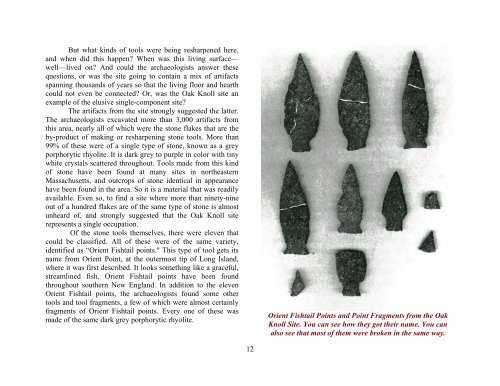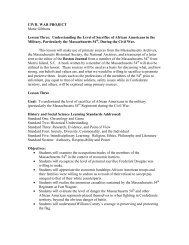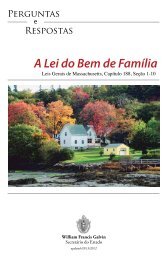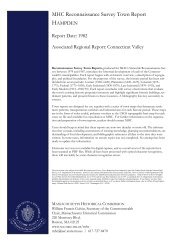Roads, Rails, and Trails - Secretary of the Commonwealth
Roads, Rails, and Trails - Secretary of the Commonwealth
Roads, Rails, and Trails - Secretary of the Commonwealth
Create successful ePaper yourself
Turn your PDF publications into a flip-book with our unique Google optimized e-Paper software.
But what kinds <strong>of</strong> tools were being resharpened here,<br />
<strong>and</strong> when did this happen? When was this living surface—<br />
well—lived on? And could <strong>the</strong> archaeologists answer <strong>the</strong>se<br />
questions, or was <strong>the</strong> site going to contain a mix <strong>of</strong> artifacts<br />
spanning thous<strong>and</strong>s <strong>of</strong> years so that <strong>the</strong> living floor <strong>and</strong> hearth<br />
could not even be connected? Or, was <strong>the</strong> Oak Knoll site an<br />
example <strong>of</strong> <strong>the</strong> elusive single-component site?<br />
The artifacts from <strong>the</strong> site strongly suggested <strong>the</strong> latter.<br />
The archaeologists excavated more than 3,000 artifacts from<br />
this area, nearly all <strong>of</strong> which were <strong>the</strong> stone flakes that are <strong>the</strong><br />
by-product <strong>of</strong> making or resharpening stone tools. More than<br />
99% <strong>of</strong> <strong>the</strong>se were <strong>of</strong> a single type <strong>of</strong> stone, known as a grey<br />
porphorytic rhyolite. It is dark grey to purple in color with tiny<br />
white crystals scattered throughout. Tools made from this kind<br />
<strong>of</strong> stone have been found at many sites in nor<strong>the</strong>astern<br />
Massachusetts, <strong>and</strong> outcrops <strong>of</strong> stone identical in appearance<br />
have been found in <strong>the</strong> area. So it is a material that was readily<br />
available. Even so, to find a site where more than ninety-nine<br />
out <strong>of</strong> a hundred flakes are <strong>of</strong> <strong>the</strong> same type <strong>of</strong> stone is almost<br />
unheard <strong>of</strong>, <strong>and</strong> strongly suggested that <strong>the</strong> Oak Knoll site<br />
represents a single occupation.<br />
.Of <strong>the</strong> stone tools <strong>the</strong>mselves, <strong>the</strong>re were eleven that<br />
could be classified. All <strong>of</strong> <strong>the</strong>se were <strong>of</strong> <strong>the</strong> same variety,<br />
identified as “Orient Fishtail points." This type <strong>of</strong> tool gets its<br />
name from Orient Point, at <strong>the</strong> outermost tip <strong>of</strong> Long Isl<strong>and</strong>,<br />
where it was first described. It looks something like a graceful,<br />
streamlined fish. Orient Fishtail points have been found<br />
throughout sou<strong>the</strong>rn New Engl<strong>and</strong>. In addition to <strong>the</strong> eleven<br />
Orient Fishtail points, <strong>the</strong> archaeologists found some o<strong>the</strong>r<br />
tools <strong>and</strong> tool fragments, a few <strong>of</strong> which were almost certainly<br />
fragments <strong>of</strong> Orient Fishtail points. Every one <strong>of</strong> <strong>the</strong>se was<br />
made <strong>of</strong> <strong>the</strong> same dark grey porphorytic rhyolite.<br />
12<br />
Orient Fishtail Points <strong>and</strong> Point Fragments from <strong>the</strong> Oak<br />
Knoll Site. You can see how <strong>the</strong>y got <strong>the</strong>ir name. You can<br />
also see that most <strong>of</strong> <strong>the</strong>m were broken in <strong>the</strong> same way.








